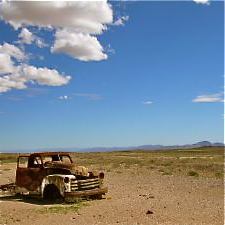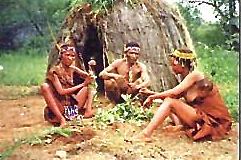 One only needs to take to the road to experience the generosity and kindness of people. The Grateful Traveler series is filled with their stories.
One only needs to take to the road to experience the generosity and kindness of people. The Grateful Traveler series is filled with their stories.
But there is another kind of giving that touches the heart and makes an indelible impression upon the soul. It comes from those who share what they have even when they have nothing.
Which is exactly what happened to Emily Hutta and John Hennessy when their truck broke down in the Kalahari Desert.
As the Rural Industrial Officer for Botswana’s Kalahari District, John’s job was to visit the widespread villages that dot this vast desert and tell people about government programs. The Kalahari District is huge with almost no roads, virtually no water (the word “Kalahari” means waterless place), and often no way to communicate or call for help.
Breaking down in the Kalahari could be a death sentence unless, like Emily and John, you have the good fortune to break down right outside a Basarwa settlement.
The Basarwa (often called Bushman, which is not a term they like) are nomadic hunters and gatherers. They do not speak the Setswana or the English of most Botswana people. Until government intervention, their children did not attend formal schools.
 Their genius lies in their ability to survive in one of the world’s harshest environments. To do this they keep moving, looking for water, looking for game, looking for plants to eat and use as medicines just as their people have done for thousands of years. What they do not do well is live in government settlements.
Their genius lies in their ability to survive in one of the world’s harshest environments. To do this they keep moving, looking for water, looking for game, looking for plants to eat and use as medicines just as their people have done for thousands of years. What they do not do well is live in government settlements.
And because this way of life is so foreign to them, these settlements tend to have a dearth of infrastructure. One cannot run to the store for food, lay in additional water supplies or offer the services of an auto repair shop.
So one would think that two Americans showing up in their midst needing food, lodging and a good mechanic would alarm and perhaps even frighten the Basarwa. Not so. In fact, they were charmed.
Most of the people at the settlement had never been inside a truck so they crawled all over it and took turns sitting in the driver’s seat. A couple of the men who had worked in South Africa (and who, like John and Emily, could speak Setswana) lent their expertise to the endeavor by holding fire to the spark plugs and getting everyone to push the truck round and round on the salt pan in an attempt to jump start it.
When it became clear that nothing would work, the Basarwa took John and Emily in.
“The thing you have to understand,” says Emily, “is that these people had no idea if we would be there a day, a week or a month, but whatever they had they were willing to share. The men still hunted with spears and whatever they killed they divided among the whole village— which now included us.”
John and Emily’s only hope for repairing their vehicle lay with the government water truck that came through about once a month, but not on any set schedule. “One morning someone was sent to tell us that the ‘old woman’ said the truck was coming,” says Emily. (Since the Basarwa do not keep track of their birthdays no one knew how old this woman was but she was revered for her knowledge.)
“You could see a long way in all directions across the bush, and none of us could see any sign of a truck,” remembers Emily. “But this woman insisted the water truck would be there in the late afternoon. Sure enough, hours later it rolled in, just as she’d predicted. She said she’d heard it coming and everyone, including us, believed her.”
Fortunately, the driver had the tools and the know-how to fix John and Emily’s truck or they would probably still be there to this day. “I have no doubt they would still be feeding us and sharing their precious water while expecting nothing in return.”
Such is the generosity of some of the world’s poorest people, Eskimos who just happen to reside in the burning heat of the African desert.
By Jamie Simons for PeterGreenberg.com.
Check out the story that started it all: Grateful Traveler: An “Eskimo” Showed Me the Way
Read more from the Grateful Traveler series in the Personal Travel Journals section.












